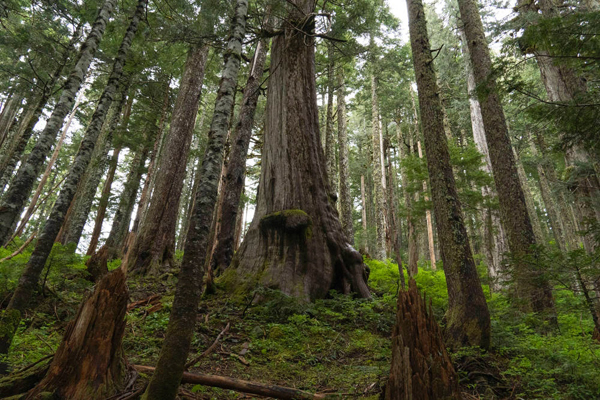For Pacheedaht First Nation, forestry is a lifeline, bringing jobs and services to the community
By the time you drive into Port Renfrew — whether it’s from Victoria or Nanaimo — chances are, you’re going to be at half a tank of gas or less, so your first stop is likely to be the Pacheedaht Gas Bar.

There, you’ll probably meet Nadine McClurg, who will cheerily top up your tank.
It’s hard to resist the urge to ask the first local you meet about what they think of the ongoing protests against old-growth logging in the Fairy Creek watershed. The typical response is a discreet rolling of the eyes and a tendency to avoid the question. For most, it’s better to steer clear of any controversy that could ruffle the feathers of their neighbours or band council.
What you might not hear, however, is that up until about three years ago, there was no permanent gas station in the Port Renfrew area. Before the Pacheedaht station, now in its third season, locals had to drive to Lake Cowichan or Sooke for fuel. It’s a one-hour trip each way, so some used to fill up on boat fuel instead from the Port Renfrew Marina, which is only open seasonally.
Some locals say the gas station, among other Pacheedaht-owned businesses, is the direct result of forestry dollars flowing into the Pacheedaht First Nation over the past decade — something that might help explain why the band council has repeatedly asked protesters trying to stop old-growth logging in the area to leave its territory.
Two-time former Pacheedaht elected chief Arliss Jones, who acknowledges it can be hard to pin down exact numbers when it comes to the First Nation’s finances, said the band has been able to purchase some “amazing stuff” in recent years for the community, including the San Juan Market grocery store and Soule Creek Lodge, an oceanview hotel perched on the San Juan Ridge that also offers accommodations in yurts.
“I’m very proud of that fact that they have gotten our foot in the door for our own businesses,” she said, adding that here, a full-time job usually means working seasonally for about nine months of the year, no matter your profession, although that’s starting to change.
Incorporating forestry revenue into the community has been the work of several elected councils over the years, and they’re now starting to reap the rewards.
“In the last 20 years, the nation has gone from having zero stake in the forestry business, apart from jobs, to being a participant in the business and owning tenure, owning assets [and] even owning land,” said Rod Bealing, forestry manager for the Pacheedaht First Nation. “In the broadest terms, forestry is helping Pacheedaht buy their land back — their unceded territory — that was taken from them. And forestry is helping them take it back bit by bit.”
In 2014, the Pacheedaht purchased land adjacent to Juan de Fuca Provincial Park after Cedar Coast Properties’ cabin development fell through. Then in 2015, the band was able to buy Browns Mountain, a site considered sacred to the Pacheedaht, after unsuccessfully trying to acquire it seven years earlier. Bealing said forest-management dollars made it all possible.
Bealing says they are unable to disclose how much money from forestry went into the new Pacheedaht investments and business ventures, but it’s in the multi-millions of dollars.
Their forestry revenue comes from four different sources. The Pacheedaht own Woodlot Licence 1957 and have a partnership with Pacheedaht Andersen Timber Holdings for Tree Farm License 61. They also have a community forest agreement for the Kala:yit Community Forest with Lake Cowichan Community Forest Co-operative, in partnership with the province, and have a Forest Consultation and Revenue Sharing Agreement with the province that is continually renewed.
In B.C., a woodlot licence is a contract to manage a plot of Crown land that comes with strict rules, but grants the right for the licensee to harvest timber on the land. Woodlot License 1957 is 397.7 hectares near the San Juan River and Lens Creek with an annual cut of 1,500 cubic metres.
A tree farm license grants the virtually exclusive right to harvest timber in return for management of conservation, recreation and cultural heritage values in the allotted area. Pacheedaht Andersen Timber Holdings’ Tree Farm Licence 61 runs along the San Juan Ridge between Port Renfrew and Jordan River and lies on a 47-kilometre stretch beside the Juan de Fuca Marine Trail. Managed from Jordan River by Pacheedaht-owned Queesto Community, the TFL has an area of about 20,240 hectares and an annual allowable cut of 101,103 cubic metres of timber.
A community forest agreement is a license for a forestry operation that is managed by a local government, First Nation or community-held organization. The Qala:yit Community Forest agreement comes with an allowable annual cut of 31,498 cubic metres over about 8,000 hectares. Of the net revenue from the harvest, 50% will be shared with the Qala:yit partners, including the Pacheedaht.
Finally, a Forest Consultation and Revenue Sharing Agreement, a program introduced in 2010 to provide economic benefits to First Nations from logging in their territories, provides a minimum payment of $35,000 per agreement per year and is made up of three per cent to five per cent of general stumpage, annual rent and waste revenues for all forestry activities. Stumpage is a fee that businesses or individuals pay when they harvest timber from Crown land in B.C.
Some First Nations, including the Pacheedaht, are also eligible for a refund of 35% to 85% of stumpage they have paid on eligible volume — in the Pacheedaht’s case, they get a refund of 40% stumpage.
The amount the band earned from the agreement has risen from $74,845 in 2017 to $242,338.
Elected Pacheedaht chief Jeff Jones noted that the percentage of income from the revenue-sharing agreement with the province is small, a sentiment echoed by Bealing. “It’s part of the puzzle and it [was] important to getting the nation forward 17 years ago,” he said. “It provides a little bit of revenue, but really it’s a drop in the bucket to the scope and scale in what’s going on in the forestry business.”
Jones stressed the band does not have any agreements or partnerships with Surrey-based forestry company Teal-Jones Group, which owns Tree Farm Licence 46 and whose plans to log old-growth forest, much of which lies in the Pacheedaht’s traditional territory, sparked the ongoing Fairy Creek protests in August of 2020. Though the logging company works within the First Nation’s traditional territory, its only relationship with the Pacheedaht is that the First Nation buys lumber from Teal Jones for its sawmill, Jones said.
Bealing says that the financial impact of the nation’s forestry business goes beyond direct jobs, because it has given them the means to acquire other businesses where their people now work — aside from the gas station, market and lodge, those businesses include Seafoam Seafoods, and the Pacheedaht Mill.
Forestry dollars are key for maintaining what they see as essential services for the community, said Bealing.
For example, the San Juan Market, the local grocery store, was on the market for years before the Pacheedaht purchased and began running it. Many people in the community don’t have access to a vehicle or just don’t want to drive to Lake Cowichan or Sooke for bread, so a grocery store is a community service, Bealing said.
But it’s challenging to run a grocery store in a small community, especially during the leaner off-season months, so forestry dollars help prop up the business, Bealing said. Otherwise, the grocery store would have left the community a long time ago.
“Those other businesses are really important, and they provide lots of important employment for community members, but they’re not necessarily self-sufficient financially,” he said. “So, that business is being subsidized by forestry business.”
One of the nation’s goals is to attract former community members to move back home with the prospect of full-time employment, and to build housing for them, Jones said — something they hope forestry revenue can help them do. Last year, the Pacheedaht built nine new homes for community members returning for work, he said. (Several Pacheedaht band members said the number is closer to six homes, and the new homes are the result of splitting existing homes into duplexes.)
Pacheedaht and its sister community of Port Renfrew are remote — they lack cell service as well as the opportunity to choose from the range of job options city folks are used to. Almost everyone leaves home to finish high school elsewhere — the local elementary school only teaches up to Grade 5. After that, families have to pack up and move to another community, or send the kids to live with other family members in communities like Sooke, Victoria or farther afield.
Nadine McClurg from the gas station says her 13-year-old son lives with his father in Ontario but would love to return — he loves climbing the trees and swimming in the rivers surrounding their home.
She also has a 23-year-old daughter who lives in Victoria, where she is pursuing an education in the trades, and has no plans to return home.
McClurg said it’s sad, but she understands. If her son were to stay with his mother and commute every day to Sooke for school, he would have to get up at 6:30 a.m. and wouldn’t return home until after five, later if it’s snowing.
But she sees the community’s situation as improving, at least in terms of jobs.
Though the number fluctuates throughout the year due to forestry’s seasonality, Bealing said about 20 Pacheedaht community members are now working directly or indirectly with forestry operations.
Bealing estimates that direct and indirect forestry jobs account for roughly 20 per cent of employment for the First Nation, which has a total membership of 284 people, about a third of whom live on the reserve.
Up in the mountains and on the logging roads a short drive from the Pacheedaht reservation, protesters remain encamped and steadfast in their efforts to protect remaining old-growth forests — even though the province in June agreed to a two-year deferral of old-growth logging in the Fairy Creek watershed and Central Walbran at the request of the Pacheedaht, Ditidaht and Huu-ay-aht First Nations, who say they want the time to prepare stewardship plans for the areas in their territories.
The Teal-Jones Group has said it will abide by the nations’ request and put a stop to harvesting and road-building in the deferral areas, which covers most, but not all, of the old-growth protesters want to protect.
Although a few vocal Pacheedaht community members, such as elder Bill Jones, have welcomed protesters to their territory, the Pacheedaht band council has released multiple statements since April telling protesters to leave.
For the Pacheedaht elected council, taking advantage of its forestry resources is a priority.
“Logging is definitely not a short-term benefit. I see it as a long-term benefit,” said Jones. “We’re heavily into the forest industry. Maybe many [people] don’t know that. We rely on the revenue every year to provide long-term stable employment.
“I’ll be honest, I don’t see any way that forestry is going to be gone. This is too important to us.”
Article by Norman Galimski;
Article and photos published in the Times Colonist on Sunday July 2021.

